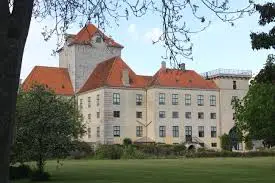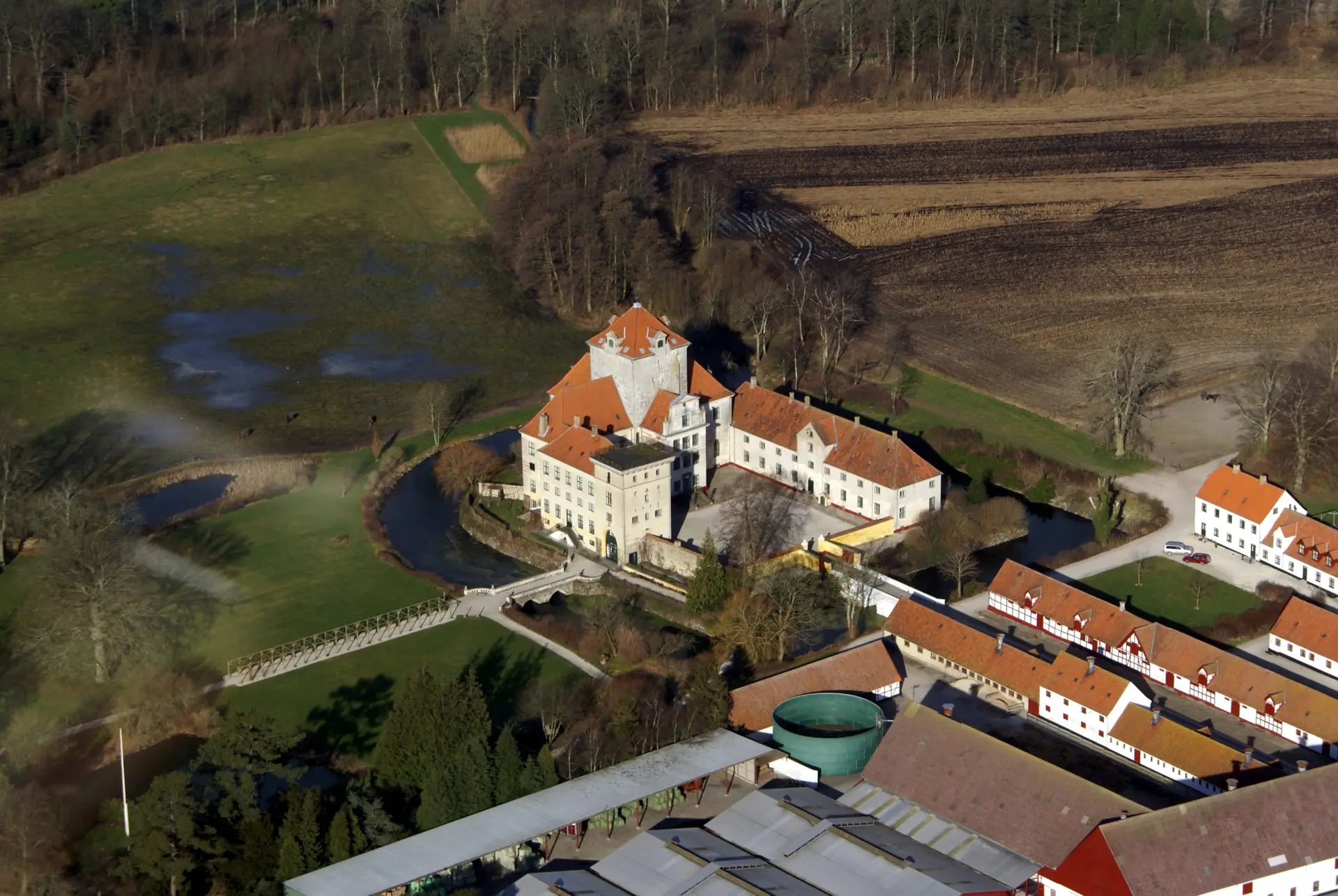Gjorslev Castle: A Majestic Relic of Denmark’s Medieval Past
Nestled on the picturesque Stevns Peninsula in eastern Denmark, Gjorslev Castle (in Danish: Gjorslev Slot) is a stunning medieval fortress that stands as a testament to the architectural brilliance and historical significance of its era. This iconic site is not just a monument of the past, but a living chronicle of Danish cultural heritage. With its striking structure and storied past, Gjorslev Castle continues to captivate historians, architecture enthusiasts, and tourists alike.
The Architectural Grandeur of Gjorslev Castle
Gjorslev Castle boasts an architectural style that combines medieval fortification with elements of domestic sophistication. Constructed primarily of limestone in 1396, the castle showcases the Middle Ages’ characteristic Gothic style, defined by its grandiose towers and imposing exterior. It is built around a courtyard and features an impressive 30-meter high tower—one of the tallest of its kind in Denmark. This central tower, originally intended as a defensive structure, highlights the castle’s dual purpose as both a fort and a noble residence.
Beyond its physical architecture, Gjorslev Castle is also known for its sumptuous interiors, which have been meticulously preserved over the centuries. The Great Hall, with its carved wooden ceilings and ornate furniture, offers a glimpse into the opulent lifestyle of medieval Danish nobility. The library and chapel are equally awe-inspiring, rich with historical artifacts and ancient manuscripts that chronicle the castle’s long and storied history.
The Historical Significance of Gjorslev Castle
The castle holds immense historical importance, serving as a vibrant chapter in Denmark’s medieval history. The influential Bishop Peder Jensen Lodehat, a close confidant of King Erik of Pomerania, built Gjorslev Castle as a bishop’s palace. Throughout the centuries, it has witnessed a myriad of historical events and has been home to various noble families who have left their mark on its hallowed halls.
Gjorslev has been linked with several significant historical figures, further solidifying its place in Danish lore. For example, King Christian IV, one of Denmark’s most renowned monarchs, is known to have made several visits to the castle, further enhancing its historical allure. Additionally, the site played a role in the tumultuous events of the Reformation, which saw Denmark transition from Catholicism to Lutheran Protestantism. During this period, authorities converted Gjorslev’s chapel for Protestant use, showcasing broader religious and societal shifts in Denmark.
Gjorslev Castle’s Legacy and Cultural Impact
Today, Gjorslev Castle stands as a symbol of Denmark’s rich medieval past and its enduring cultural legacy. It has been declared a protected historical site, ensuring its preservation for future generations. The castle’s continued relevance is highlighted by its role in academia and popular media. It serves as a resource for historians and architects studying the gothic and medieval periods, offering insights into construction techniques and noble lifestyles of the time.
Moreover, Gjorslev Castle has captured the public’s imagination, featuring prominently in Danish folklore and literature. Tales of haunted chambers and noble intrigues abound, adding an air of mystery and enchantment to the site. The castle’s picturesque setting has also made it a popular choice for film and television productions seeking to capture the medieval ambiance.
Through its centuries-old walls, Gjorslev Castle whispers the stories of a nation’s past, tales of power, religion, art, and life that have shaped Denmark’s national identity. Whether as a historical site or an architectural marvel, its importance cannot be overstated. The fortress, with its formidable presence, invites exploration and admiration, making it a remarkable site for anyone interested in delving into Denmark’s medieval history.

Planning Your Visit to Gjorslev Castle
Gjorslev Castle, with its inviting aura and historical allure, is a must-see destination for anyone exploring Denmark’s rich heritage. Open June to August, the castle offers guided tours; thus, visitors step back in time and explore its stories. If you’re planning a visit, it is essential to familiarize yourself with the castle’s visiting hours and tour schedules to make the most of your journey.
How to Get to Gjorslev Castle
Located approximately 60 kilometers south of Copenhagen, Gjorslev Castle is easily accessible by car and public transport. Drive from the capital and reach Stevns Peninsula in an hour, thus enjoying a quick countryside escape. Alternatively, for those preferring public transport, there are regular train and bus services from Copenhagen to the nearby town of Store Heddinge, where Gjorslev Castle is situated just a few kilometers away. Local bus services or a short taxi ride can then complete your journey to the castle grounds.
Visiting Tips and Recommendations
To optimize your visit to Gjorslev Castle, consider these tips to ensure a memorable and enriching experience:
1. Plan Ahead: Since guided tours are the highlight of the castle visit, it’s wise to book your tickets in advance, especially during peak tourist season. Tours are typically conducted in Danish, but there are often multilingual guides available upon prior request.
2. Embrace the Outdoors: The castle is surrounded by lush gardens and scenic landscapes, perfect for a leisurely stroll or a picnic. Plan to spend some time outdoors enjoying the serene beauty of the castle grounds, which offer striking views and photo opportunities.
3. Explore Nearby Attractions: The Stevns Peninsula is home to several other attractions, such as the UNESCO-listed Stevns Klint cliffs, known for their unique chalk formations and geological significance. A visit to Gjorslev Castle can easily be combined with these nearby sites, making for a full day of exploration and adventure.
4. Consider Special Events: Gjorslev Castle occasionally hosts special events such as medieval reenactments, cultural festivals, and art exhibitions. Checking the castle’s event calendar beforehand can enhance your experience by offering additional insights into Danish culture and history.
Accessibility and Amenities
Gjorslev Castle strives to be accessible and welcoming to all visitors, though it’s worth noting that some areas of the castle may be challenging for those with limited mobility due to the historical nature of its architecture. However, the staff is typically accommodating and can offer assistance or guidance as needed.
Amenities at Gjorslev Castle include a small café offering light refreshments, which provides a delightful spot to relax and reflect on the day’s exploration. Additionally, a gift shop with local crafts and souvenirs is available, allowing visitors to bring a piece of Danish history home with them.
Best Times to Visit
While the summer months tend to attract the most visitors due to favorable weather, Gjorslev Castle’s charm transcends seasons. Visiting during the off-peak months of early spring or late autumn can offer a more intimate experience, with fewer crowds and a serene atmosphere that can heighten the timeless tranquility of the castle. Keep in mind, though, that some facilities might have limited availability outside of the summer period.
In summary, Gjorslev Castle is not just a destination but a journey through Denmark’s rich and vibrant history. Plan your visit carefully; as a result, you’ll enjoy an engaging experience that showcases the castle’s grandeur and legacy.
Conclusion
Gjorslev Castle stands as a towering emblem of Denmark’s medieval history, blending architectural splendor with centuries of rich cultural narratives. From its imposing Gothic structure and lavish interiors to its significant role in historical events and its enduring cultural impact, the castle is a place where the past comes alive. A visit to Gjorslev is more than just a step back in time; it is an opportunity to engage with a crucial chapter of Danish heritage. Whether you explore grand halls or stroll the peaceful grounds, Gjorslev Castle offers an unforgettable historical journey.
Summary
– Gjorslev Castle is a medieval castle located on the Stevns Peninsula in Denmark, built in 1396 using limestone in an impressive Gothic style.
– The castle was initially a bishop’s palace and has historical ties to significant figures and events, such as the Reformation in Denmark.
– Visitors can experience guided tours primarily during summer months and explore the lush gardens and breathtaking landscapes around the site.
– Easily accessible from Copenhagen, Gjorslev Castle combines perfectly with nearby attractions like Stevns Klint for a full-day excursion.
– Special events and exhibitions further enrich the visitor experience, showcasing Danish culture and history.
Frequently Asked Questions about Gjorslev Castle
1. Is Gjorslev Castle open to the public?
Yes: Gjorslev Castle is open to the public, primarily for guided tours during the summer months from June to August. It is advisable to check specific visiting hours and tour schedules ahead of time.
2. How do I get to Gjorslev Castle from Copenhagen?
Visitors can reach Gjorslev Castle by car in roughly one hour from Copenhagen, heading south to the Stevns Peninsula. Public transportation options include trains and buses to Store Heddinge, followed by a local bus or taxi to the castle.
3. Are the tours available in languages other than Danish?
Most tours use Danish; however, guests can request multilingual guides in advance, especially during peak tourist seasons.
4. Does the castle accommodate visitors with limited mobility?
Gjorslev Castle makes efforts to accommodate visitors with limited mobility. However, due to the historic architecture, some areas may present accessibility challenges. Visitors are urged to contact the castle in advance to discuss specific needs.
5. Can I host an event or wedding at Gjorslev Castle?
Gjorslev Castle hosts events; however, contact the administration about private bookings or weddings, as policies may vary.
6. What amenities are available at the castle?
The castle features a small café for light refreshments and a gift shop offering local crafts and souvenirs. These amenities enhance the overall visitor experience.
7. Are there any fun activities for children at the castle?
Yes, children enjoy exploring the castle grounds and joining fun events like historical reenactments and seasonal festivals.
8. What are some nearby attractions to visit along with Gjorslev Castle?
The Stevns Peninsula offers several attractions, including the UNESCO-listed Stevns Klint cliffs and other historical sites. Combining these locations with a castle visit creates an enriching full-day adventure.
9. Does Gjorslev Castle have any annual special events?
Yes, the castle sometimes hosts annual special events, including medieval fairs, art exhibitions, and cultural festivals. Checking the castle’s event calendar ahead of your visit can enhance your experience.
Explore Gjorslev Castle to dive into Denmark’s medieval history, it captivates visitors with grandeur and timeless stories. Each visit offers an enriching experience; moreover, it invites everyone to appreciate preserved Danish culture and heritage.




